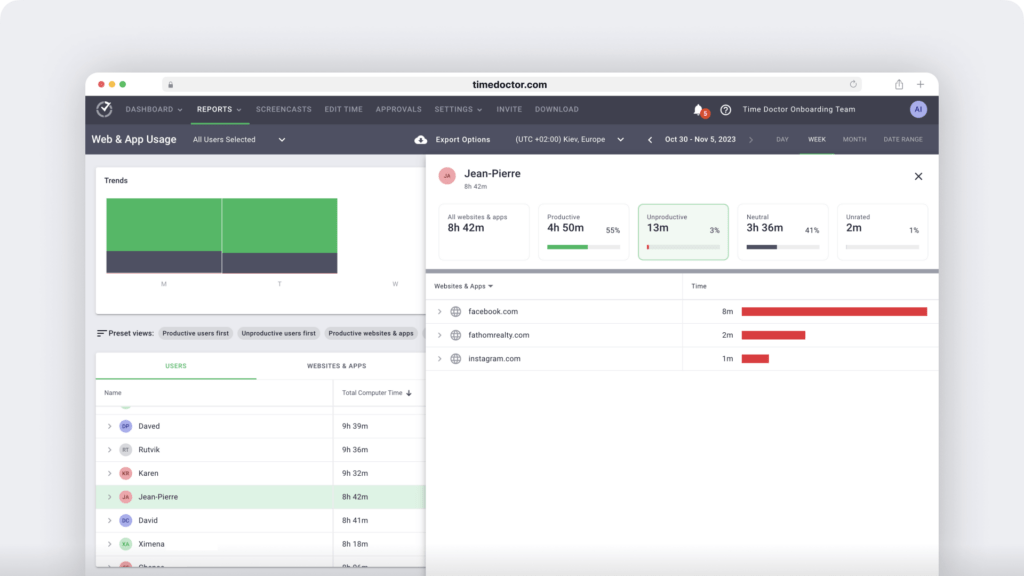Finding it hard to conduct an employee performance assessment for remote employees?
Performance reviews can be intimidating enough as they are. And with the COVID-19 pandemic forcing companies to switch to remote work arrangements, managers are facing an entirely new set of challenges this time around.
But don’t worry.
In this article, we’ll cover everything you need to know about conducting employee performance assessments for virtual employees. We’ll talk about the different methods you can use to evaluate performance and cover 7 tips to improve your performance review process.
Table of Contents
- How does performance evaluation differ for remote employees?
- 3 ways to conduct employee performance assessment for remote employees
- 7 tips to improve remote performance reviews
Let’s get started.
How does performance evaluation differ for remote employees?
To adapt your performance assessments for a remote team, you first need to know what needs to be changed.
After all, your remote team isn’t in the same setting and doesn’t face the same challenges your in-office team does. So evaluating them on the same parameters would be unfair, right?
Here’s what you should keep in mind:
A. Communication
Communication is one of the most important aspects to consider while arranging remote employee assessments.
Remember that you’re not physically with your remote staff as you would’ve been in an office environment. And it’s this absence of body language and gestures that can make communication and assessment difficult.
Keep this in mind while choosing a digital platform to conduct your performance review process. Ideally, choose a video conferencing platform that gives you some level of face-to-face interaction and allows you to pick up on some body language cues.
B. Biases
Telework (or remote work) can also increase the chances of bias towards employees as you can’t directly monitor their work every day. For example, you may expect good performers to work better and view their results more favorably as compared to others.
Take some time to consider such biases and ensure that they don’t impact your assessments, decisions or how you set goals.
C. Employee challenges
Additionally, remember that the Coronavirus pandemic has severely impacted employee performance. They could be dealing with various struggles, such as taking care of their children or simply adapting to remote work and a new work-life balance for the first time.
Encourage your employees to talk about any issues they may be facing and help them adjust their work process accordingly.
3 ways to conduct employee performance assessment for remote employees
So how exactly should you go about assessing remote employee performance?
Here are 3 methods you can use to improve your performance evaluation:
1. Self-evaluation
Self-evaluation involves feedback about your employee from themselves.
Why do you need this?
Self-evaluations help you gain a holistic view of an employee’s work, performance and the way they operate. They also tell the remote worker that their perspectives matter and help them reflect on their own work.
How do you go about it?
Self-evaluation for a performance review usually consists of at least 5-7 multiple choice questions, as well as a few open-ended questions that allow employees to further express their thoughts.
Compare each employee’s self-evaluation with other information or reviews to gain a better understanding. Identify where the different perspectives match and differ to recognize key factors, like employees’ main strengths or areas where they could improve.
2. Internal and peer reviews
Internal and peer reviews involve feedback from people that work closely with an employee, such as a remote team member.
These can cover several aspects, from their work performance and work ethic to soft skills such as communication and leadership.
Used alongside self-evaluations, peer reviews can give you a detailed view of how individuals and even an entire team works together. This is critical for identifying the factors behind exceptional/poor performance so you can optimize work processes as required.
Internal reviews also give you insight into hurdles or strengths that you hadn’t considered or been aware of. The additional perspectives help eliminate your own biases and assess worker performance with greater accuracy.
3. Measure performance against key metrics
While subjective reviews are important, performance assessments can be extremely difficult without any objective data to measure!
In order to create an accurate picture, you need to measure remote workforce performance against key metrics like a KPI or a set of deliverables. These should relate to organizational goals or their individual quarterly goals to measure the value an employee brings to the table.
For example, instead of measuring the time worked by each employee without any contextual data, you could measure the amount of time they spent on productive tasks. You can compare this data across employees in similar roles to set clear expectations and gauge individual employee performance.
7 tips to improve remote performance reviews
You now know a few of the key methods to go about evaluating your employee performance.

However, that isn’t enough.
In order to truly take your employee performance assessment to the next level, here are seven key tips you must keep in mind:
1. Build trust with your remote team members
Getting your employees to trust you has always been helpful – but for remote employee reviews, this is essential.
Allow and even encourage your employees to communicate freely with you. This makes it easier for them to open up about any struggles they face that could be interfering with their performance.
Additionally, building trust will make your employee performance assessments much easier.
How?
By eliminating emotions of fear and distrust, you can communicate and give your employees feedback in a more relaxed manner.
This also makes it easier for your employees to receive criticism. In turn, they’re more likely to use your critiques to improve their performance, increasing the value of the employee performance assessments.
2. Give regular feedback via frequent performance reviews
Traditionally, employee performance assessments are held as an annual performance review. However, annual reviews aren’t ideal today, especially for remote work.
Why?
To bridge the communication gap in a remote workplace, remote team managers should aim to give regular feedback to their employees.
One of the best ways to do this is to hold frequent, shorter performance reviews.
How do these help?
Real-time feedback allows employees to continually improve their performance and assures them that they’re on the right track.
Frequent performance assessments also help remote team managers keep a closer track of a distributed team to make managing remote employees easier.
Additionally, by increasing the frequency of performance reviews, you reduce the stress and burden associated with these check-ins. It helps employees get used to performance reviews and view them as a productive practice rather than a dreaded annual assessment.
Ensure that you include positive feedback along with critiques for each assessment. This way, employees know what they’re doing right and will be more receptive to criticism that can boost employee progress and help them set clear goals.
3. Establish effective communication
As we’ve seen, communication can be a huge barrier to distributed workforce productivity.
In order to overcome this hurdle, you need to establish an effective framework of communication for your virtual team.
How can you do this?
Make sure you conduct performance assessments over a video conferencing tool like Zoom or Face Time rather than a text-based platform such as Slack or email. This way, you can read cues like body language and tone for effective communication.
In addition, try to restrict performance reviews to one-on-one or smaller group calls rather than a full-blown virtual team meeting. This helps employees feel comfortable and express their thoughts freely without considering what others may think.
Also remember to structure your assessments to allow both parties to speak at length without restricting time limits.
4. Listen to your employees and help them adapt
Although you’re giving your employees their performance reviews, this doesn’t mean that you don’t take the time to listen to them as well!
By listening to your employees, you can help them adapt to their remote work lifestyle and deal with struggles they are facing, which is vital for improving employee engagement.
Not only does this help employees overcome their issues, but they also feel valued during the assessment. This helps make performance reviews a collaborative effort, boosts employee morale and reduces the burden placed on the manager.
Listening to your employee allows you to adjust your feedback and goal-setting to best suit them. You can give better, actionable advice that can actually result in improved performance.
5. Recognize your own biases and keep them in mind
Internal biases can easily be exaggerated while working remotely.
These can include:
- Looking favorably at the performance of employees who’ve been good employees in the past.
- Tending to see the work of average performers in a more critical light.
- Viewing the work of employees you’re close to in a more favorable manner.
Aside from harming the fairness of your performance reviews, such biases can pressure good performers into overworking or discourage average performers from improving.
So how do you deal with these?
In order to ensure a fair employee performance assessment, remote team managers need to take the possibility of such biases into account and try to recognize these.
You must actively take steps to counteract such biases, such as:
- Gathering feedback from a wide range of sources.
- Measuring performance against an objective KPI or performance metrics.
- Using self-evaluations to identify discrepancies in your perception of their work.
Such steps help you recognize whether your own perception is biased or limited. They’ll allow you to gain a holistic view of each employee’s performance for better assessments.
6. Consider soft skills as well as objective results
Although objective results are an important factor while considering an employee’s contribution, they’re not enough.
Aspects like soft skills and talents play a huge role in contributing to remote team performance. These can help you determine the potential your employees possess.
Important soft skills to take into account could include:
- Communication skills and efforts.
- Leadership and performance management.
- Cooperation and teamwork.
- Independence, decision-making and many more.
How do you measure these?
As most of these skills can’t be measured objectively, self-evaluations and peer reviews are a great way to observe them.
For your employee reviews, ensure that you keep soft skills in mind along with their individual results and output. Recognize their efforts in both aspects and encourage them to improve on the areas they lack in.
7. Use an employee productivity tracking tool
When it comes to tracking employee progress and performance, your own insights are not enough.
You need a powerful employee productivity tracking tool like Time Doctor to accurately track their day-to-day work.
What is Time Doctor?

Time Doctor is a powerful performance management and productivity tracking tool used by huge companies as well as smaller businesses to measure their employee performance accurately.
Time Doctor helps you:
- Generate detailed reports and analytics for performance reviews.
- Observe what websites and apps your team spends their work hours on.
- Track employee productivity using a robust set of features.
- Track the time employees spend on each task.
- Easily export data across several platforms.
How Time Doctor can transform your remote performance reviews
Time Doctor’s various reports can play a vital role in improving your employee performance assessments.
Here’s a closer look at these:
1. Activity summary report: Displays active, productive and unproductive time for each user within a given time period.
2. Hour tracked: Displays the number of work hours tracked by your employees in a single day, week or custom time range.
3. Productivity: Calculates productive and unproductive time tracked by employees based on Productivity Ratings for each website and app.
4. Projects and tasks: Displays time spent per project and on each task per user.
5. Timeline: Provides a detailed chronological breakdown of each employee’s day or week.
6. Timeline – detailed: Similar to the Timeline Report, with additional details such as task breakdowns, start and end times.
7. Web and app usage: Shows time spent on various websites and apps by each employee.

Time Doctor’s shareable and exportable reports give you detailed insights into employee work patterns and productivity.
This helps you compare the performance of employees in similar roles and identify barriers to productivity, which can be addressed in performance reviews.
Final thoughts
Employee performance assessment is never an easy task.
And when it comes to remote working, it can seem even more difficult.
However, with the tips in the article above, you’ll be all set to conduct your performance reviews with ease.
And to truly take your employee performance reviews to the next level, use a productivity tracking tool like Time Doctor. Its detailed insights and statistics will boost your assessments for virtual employees across the board!
So why not sign up for Time Doctor and transform your performance assessments today?

Liam Martin is a serial entrepreneur, co-founder of Time Doctor, Staff.com, and the Running Remote Conference, and author of the Wall Street Journal bestseller, “Running Remote.” He advocates for remote work and helps businesses optimize their remote teams.


